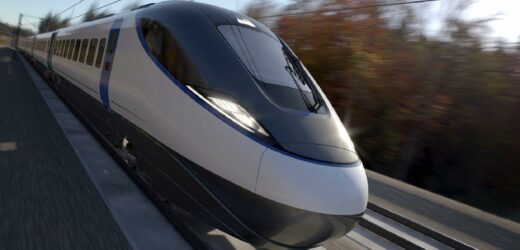Although nearly every country is still recovering from the effects of the pandemic, that never stopped their governments from spending heavily, especially regarding infrastructure. In some cases, these projects aim to create jobs; in rare cases, they are just made to show off a country’s resources. This project is ten times more expensive than the Tren Maya project which only costs $10 Billion.
Possibly becoming the fastest railway in Europe, the next big project underway is the high-speed 2 railway. Aside from their royals and historical architecture, the United Kingdom is gaining attention for its highly budget railway project. However, this isn’t the first time Britain has built a high-speed railway in the country as they had already succeeded in making the High Speed 1 or the Channel Tunnel Rail Link back in 2007.
The said project costs almost $6 billion to build. Now, they are taking in a more extensive project with a faster and much more expensive reported budget of $100 billion.
RELATED: Inside Gran Turismo Mediterranea: The $10 Million Megayacht With A Ferrari Garage
Becoming Britain’s Second High-Speed Line
Once the HS2 is finished, the new track will extend from its southernmost point in London to its northernmost point in Manchester. It will have branches reaching Birmingham and the East Midlands, as stated by the British government. After High Speed 1, which links London to the Channel Tunnel, HS2 will be the second high-speed line in the country.
The BBC reports that the new railway’s construction will be completed in three phases: Phase 1 will connect London and the West Midlands; Phase 2-a will link the West Midlands to the North via Crewe. The Phase 2-b will complete the railway to Manchester and Leeds. This will be a great project for the Manchester United fans who wanted to see the Manchester United players in person. Changes were made, though, as time went on. The government soon decided to abandon the section of HS2 that would have connected the East Midlands with Leeds.
Instead, they will build a new station called East Midlands Parkway, roughly six miles southwest of Nottingham, with HS2 trains continuing on upgraded mainline tracks to Sheffield. Northern Powerhouse Rail (NPR) will consist of new methods and improvements to existing infrastructure, even though plans for a new line between Manchester and Leeds via Bradford have been scrapped.
Two different types of trains can travel at the maximum speed of 400 kph on HS2. However, the latter can also use the old conventional tracks to get to places that aren’t directly along the HS2 route. Meanwhile, cities and towns away from the high-speed spine will be served by traditional trains that run on high-speed and conventional tracks.
The Backbone Of Britain’s Transport Network
The company constructing the HS2 claims that the new high speed railway will form as the backbone of Britain’s transport network. After many setbacks, the primary construction phases finally finished in September 2020. Although the whole operation in general is still a work in progress. Phase 1’s civil construction costs around $6.6 billion, with preliminary work comprising drilling over 8,000 boreholes to examine the subsurface.
The civil construction of HS2 is reportedly ongoing at over 300 locations between the West Midlands and London, generating at least 25,000 employees. The BBC reported that the opening of the London–Birmingham section was scheduled for the year 2026. Originally expected to debut in 2032–2033, the second stage has been postponed until 2035–2040.
The expected annual passenger volume on HS2 is 85 million, with the maximum hourly capacity of HS2 being 26,000. Boarding the transport line might even feel like a first class passenger in an airline. As many as 17 trains per hour will likely use the line to get to and from Euston. The British government also hopes that by 2033, HS2 will have up to 18 trains leaving and arriving from London every hour.
In 2010, the government predicted that HS2 would cost between $30.9 billion and $36 billion to build; in 2015, the combined estimate for building costs and rolling stock, including inflation adjustments, yielded a budget of 456.6 billion. According to Oakervee’s analysis in 2019, the original ‘Y’ network might cost as much as $87 billion at 2019 prices. Now, it is reported to cost $100 billion.
The Cutting Edge Technology
The HS2 project has been criticized despite including cutting-edge components and amenities. People who disagree with the plan say it will harm the environment and the economy. The rise of remote work has led some to argue that COVID-19 has undermined the network’s primary selling point: intercity commuters.
While many support this project, some say that the government may put the billions of dollars spent on it to better use elsewhere. However the government wanted to provide the best transport system for the people to serve the best and worst commuters in the world.
The total cost of HS2, critics say, could pay for four million students to attend college or fund Britain’s National Health Service for a year. The negative impact HS2 would have on the ecosystem is at the forefront of the opposition. HS2 Action Alliance claims that Phase One construction will continue for at least another five years, causing irreparable harm to species of European, national, and county significance.
As a result, the government commissioned a study of the project led by the previous chairman, Douglas Oakervee, in 2019 in response to criticism; the review concluded that the project should continue in its current form. However, due to the North and Midlands Integrated Rail Plan, the HS2 project scaled back this and the related Northern Powerhouse Rail project.
READ NEXT: The Richest Kid In The World: Inside The Lavish Life Of Princess Charlotte Of Cambridge
Sources: Railway Technology, The B 1M, Euro News Reuters, New Civil Engineer
Source: Read Full Article


